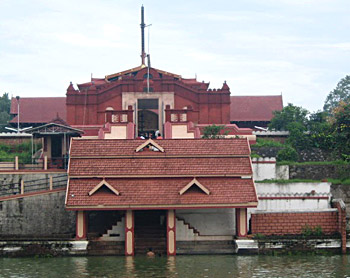 The Tiruvangad temple which, when viewed from the east, gives the appearance of a fort, finds repeated mention in the history of North Kerala. Several talks between the temple authorities on the one hand and the nadu-vazhis or Governors on the other, with representatives of the East India Company are said to have taken place in the premises of this temple. In 1750 when the combined forces of Kolathunad, Kottayam and Kadathunad lay siege on Tellicherry, irked by the machinations of the chief of Tellicherry Fort, Dorril, several strategic forts were captured. This included Tiruvangad also. In 1766 when Haider marched his army into North Kerala and the palace of Kolattiri at Chirakkal was seized its members took refuge in the Tiruvangad temple. Again when Tipu attacked the temple, its massive walls and the seven-storey gopuram were destroyed by his army. The plinth of these walls and gopuram are visible today.
The Tiruvangad temple which, when viewed from the east, gives the appearance of a fort, finds repeated mention in the history of North Kerala. Several talks between the temple authorities on the one hand and the nadu-vazhis or Governors on the other, with representatives of the East India Company are said to have taken place in the premises of this temple. In 1750 when the combined forces of Kolathunad, Kottayam and Kadathunad lay siege on Tellicherry, irked by the machinations of the chief of Tellicherry Fort, Dorril, several strategic forts were captured. This included Tiruvangad also. In 1766 when Haider marched his army into North Kerala and the palace of Kolattiri at Chirakkal was seized its members took refuge in the Tiruvangad temple. Again when Tipu attacked the temple, its massive walls and the seven-storey gopuram were destroyed by his army. The plinth of these walls and gopuram are visible today.
The story goes that when Tipu directed his guns against the eastern gopuram from a nearby hill, a bullet from the temple in retaliation hit Tipu`s cannon and immobilised it. Following this he had to stop the operations and stage a retreat. The place where Tipu assembled his army was known as `perum porkalam`, literally large battlefield. This name in course of time came to be known as `perumkalam`. The pallivetta, the hunting expedition of the Lord during utsavam is conducted here.
Though the temple was desecrated by Tipu, it is noteworthy that the British were sympathetic towards it and one of its sub-collectors, namely Thomas Harvey Baber even turned a staunch devotee of the deity and became a regular visitor to the temple. It is said that once Baber was passing through the temple galloping on his horse. The horse suddenly stopped in its course and would neither go back nor go forward. Baber realised that that happened because he was indifferent to the Lord. He made amends and thus became a devotee of Lord Rama. It was he who constructed the massive outer walls of the temple as is revealed by the following inscription: "The wall around this pagoda was constructed under the supervision and patronage of T.H. Baber esq. in 1815.





















